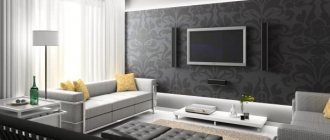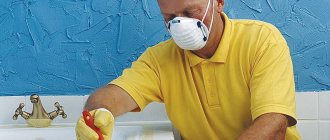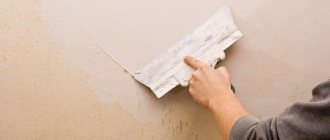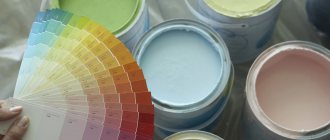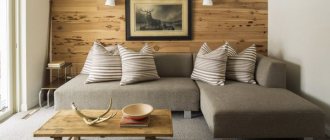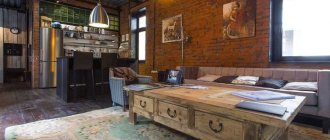The technology of wall painting as a service appeared in response to the growing popularity of decorating rooms using acrylic paints. Today, many companies provide this type of service.
Artistic wall painting has firmly become fashionable in interior design, as it allows you to add expressiveness and uniqueness to the interior.
We will tell you in detail what you need to know when ordering acrylic wall painting. At the same time, it is important to take into account that when making such a request to specialists, the latter will not only carry out the painting, but will help you decide on your own design, which is not similar to any others and is suitable exclusively for a specific interior style. The result of the work done will be a unique acrylic painting of the walls in accordance with the wishes of the owner of the room.
Sequence of wall painting
There are several main points of the procedure:
The very initial stage in wall painting is creating a project on a sheet of paper.
- first they look for an idea and motive for transforming the wall with decor;
- then several sketches are developed, from which the optimal option for further wall painting is selected, which best meets the customer’s requirements;
- preparation of the wall surface (in particular, its primer);
- copying a sketch of a drawing on the wall and outlining the composition in lines;
- execution of base painting in color with elaboration of local spots of the composition, volumes and details;
- application of varnish with a matte tint to the finished painting to ensure the durability of the painting surface. The painting is completed.
A well-chosen drawing with the participation of a designer can present a room in the most favorable light with a visual delineation of space that will not go unnoticed even by a viewer experienced in such matters.
Where to start
Acrylic painting on a wall is impossible without proper surface preparation. How tedious and time-consuming this process will be depends on the initial condition of the wall and the type of its initial finish. If the room is covered with wallpaper, you will have to remove it.
Oil or alkyd paint also needs to be removed, because the acrylic coloring composition will not adhere to such a coating. The plastered surface does not need cleaning if the material lies flat and does not crumble. How to prepare a wall:
All! The surface is prepared.
Material base of wall painting
Acrylate primer is used to treat the wall before painting.
Acrylate primer - it is used to treat the surface of the wall; if necessary, it is covered with an acrylic artistic primer. For rooms with high humidity, special soils that are resistant to moisture are used, with additives against fungi and mold.
Painting is often represented with acrylic paints, but if desired, it is possible to paint walls with oil paints. For rooms with high humidity, special acrylic paints are also used, which make it possible to obtain sufficiently durable surfaces.
For wall painting, modern industry produces acrylic paints that impress with their wide range. Thanks to the unlimited choice of painting media, there is the opportunity for creative drawings that perfectly harmonize with the interior of any room.
At the moment, acrylic paints are used in the process of decorating walls and ceilings of rooms:
To paint the walls you will need acrylic paints of various colors.
- with a standard set of colors;
- fluorescent - glowing when illuminated with ultraviolet light;
- invisible - they are invisible in typical lighting, but they are able to “come to life” when illuminated with ultraviolet light, diluting the interior space with the effect of surprise;
- luminous - they save in daylight and spread light in the dark;
- mother-of-pearl;
- metallic or glitter;
- for swimming pools (moisture-resistant acrylic).
Please note: the combination of different color options of paints allows you to obtain a unique charm in the style of the room when painting walls with acrylic.
Acrylic paints have particular versatility: they can be used to paint on any surface, using both body strokes and glazes. Acrylic painting after drying forms a durable film that cannot be washed off with water. Therefore, caring for a wall with a pattern is very simple - just wipe the surface with a damp cloth.
Work is carried out with brushes (squirrel, bristles, synthetics), palette knives, rollers, foam rubber, pieces of paper, fabric, tape. An airbrush is not so appropriate here, since its use is more appropriate for painting the surfaces of equipment (phone, car, laptop), but not the interior.
The finished drawing is coated with a matte varnish, which enhances the protection of the wall painting.
All specified materials are included in the cost of painting; they do not provide for separate payment.
Interior for a children's room
In the nursery, thanks to wall paintings, you can create a real fairy-tale kingdom.
On the walls in the room there are depictions of a mysterious forest, characters from cartoons and fairy tales. That is why you need to choose light blue, pink, light green or peach tones for decoration.
It is better not to choose gray and gloomy shades, as this frightens the baby and does not contribute to his creative development.
For harmonious development, the baby needs many small details that will attract attention. Alphanumeric combinations on surfaces are relevant for preschoolers
For little girls, it is better to choose fairy-tale characters and princesses, while boys will like technology and pirates. During adolescence, there comes a time when a child becomes interested in comics and anime characters. Take these motives into account when making repairs.
Get ready for the fact that children's interests change very quickly, so it is quite possible that in a year or two you will have to change the decor.
Advantages of acrylic wall painting
Painting with acrylic is popular for a reason, but because of its benefits compared to other types of material. And they are clear:
The advantages of painting walls with acrylic paints include the minimum drying time of the paint and the brightness of the colors.
- short drying period;
- she is not afraid of direct rays of the sun and ultraviolet radiation;
- resistance against various substances of chemical and physical origin;
- acrylic drawing is much more colorful;
- non-toxic, that is, does not contain hazardous solvents, therefore, environmentally friendly;
- has no odor;
- acrylic material can be easily corrected if necessary to correct the image;
- water resistance.
An additional advantage of their use is the manufacturer's warranty. Acrylic painting does not fade under the influence of the sun and does not fade over time.
Due to its safety for health, acrylic can be used to paint walls in children's rooms, bedrooms, and kitchens.
Of course, the quality of any paint will not fully manifest itself if the surface being painted is not properly prepared. It is possible to prepare the wall yourself, but it is much better if the masters do this, since this stage of work will largely determine the final result of the entire multi-stage process of wall painting.
Synthetic and organic acrylic paints have their own top manufacturers:
For fashionable shades and rich colors, you need to purchase paints with synthetic pigments (for the living room, lofts, halls).
For pastel, soft colors in a bedroom or nursery, it is better to use organic acrylic paints.
It’s always like this: on the website one price is indicated, over the phone they will tell you the second option, but in fact you will get a third one. The average price for wall painting services is 4,500 rubles. per 1 m², price range from 2300 to 12000 per 1 m².
The key to creativity is not knowing the end result, but it should ultimately pleasantly surprise everyone.
Source
Preparing walls for painting
Scheme for painting walls with acrylic paints.
The quality of surface preparation is very important, since the lifetime of the pattern itself largely depends on this step. If the surface is not properly prepared, over time the painting may crack along with the layer of plaster (putty), peel off, change color or crumble.
Preparing the wall surface for artistic decoration begins with clearing away layers of the previous coating, pieces of poorly retained plaster, whitewash and other things that interfere with the creation of the image. At the same time, the wall is examined for cracks.
Having removed everything old, they then proceed to degreasing the coating to ensure good adhesion of subsequent layers of plaster to the wall surface. This procedure is done using construction primers or regular white spirit.
The next point is to align the plane under the drawing. Classic leveling involves two stages: in the first, significant differences in the surface are removed by applying one or two layers of plaster, in the second, the entire plane is brought to perfect evenness (using finishing putty). After drying, the plaster layers are sanded, after which dust is removed.
When finishing a partition with plasterboard, puttying is performed only at the joints and fastenings of the sheets. When leveling the wall base, there are some nuances that experienced specialists know very well. These include the rules for choosing dry mixes and drywall for rooms with varying degrees of humidity. They should definitely be taken into account when working.
All described procedures are performed by a team of master builders. The final touch, which finally creates the base for applying the pattern, is treating the wall surface with an acrylic primer using a brush or roller. The primer creates a durable layer of protection that prevents the material from crumbling, strengthening it. Provides excellent adhesion of paint to the base. For rooms with different degrees of humidity, different primers are also used.
Acrylic painting technology
Wall painting is widely used for museums and galleries.
Using acrylic painting, you can create different decor from drawings and artistic compositions on the wall. Moreover, various stylistic trends can be involved (for example, surrealism, plant landscape or abstractionism).
Today, acrylic is widely used to create wall images not only in residential and public buildings, but also in museums and ancient estates. It harmonizes perfectly with decorative plaster and stencil technology. This provides the opportunity to create a variety of picturesque wall masterpieces. The combination of different application techniques allows you to create textured images.
What is Fluid Art
Liquid acrylic, or fluid art, is a modern type of abstract painting where paint flows across the canvas and creates color effects.
This technique is based not only on academic rules, but also on differences in the composition of paints. Paintings using fluid art technique fit perfectly into almost any interior.
So what is the secret to the success of FLUID ART?
- You don't need any special training;
- Everyone will get the job, and it will be original and unique; no one will have a second one like it!
- The more you master this technique, the cooler and more professional the works will be, and therefore their cost, if you want to sell them;
- Doesn’t take a lot of time, like oil, for example;
- This is a very meditative technique, calming and relaxing.
The use of different bases in interior wall painting
Depending on the circumstances and requirements of customers, the base for painting can be provided differently. The canvas is glued to the wall after the image is applied to it, or it is mounted together with a stretcher in the place allocated for painting. Painting a wall on a fine plaster layer is a classic version of the basis for wall painting.
Canvas is convenient when, for some reason, the artist cannot visit the painting site, but the work cannot be completed without delay. In this situation, a monumental work takes on the features of a mobile one. This is especially valuable not only for the moment of installation, but for the future (for example, in case of damage to the plaster layer). Then, to repair the wall, the painting is simply removed and placed where needed. But such a base has a small disadvantage - the formation of a large area of joints on the canvases due to the limited size of the canvas in width.
Painting directly on a stationary surface is convenient in all situations and for any room.
https://moyagostinaya.ru/youtu.be/Xy2ek8JBzkc
The main thing is to take care of preparing the base, since then the drawing will not be separated from it.
Selection of drawing
The choice of subject, colorful materials and image size depend on the room in which the painting will be carried out. It is necessary to take into account the interior, the style of the room, lighting and the tasks assigned to the artist.
Bedroom
This is a place of rest and sleep. When choosing a subject, avoid images with raging elements: waterfalls, stormy rivers, tongues of fire. Wild animals and scenes of fading nature will also be inappropriate.
Calm landscapes and flowering plants, flowers and trees, birds and butterflies, a beautiful sky, a smooth lake surface with water lilies will look great.
Bathroom
If you want to decorate your bathroom with painting, then you need to follow a few rules:
- For work you should use moisture-resistant plaster.
- Give preference to moisture-resistant paints, such as acrylic. When the paint layer dries, a film forms and will prevent contact with water.
- After finishing painting, cover the image with protective varnish, maybe 2-3 layers.
By following these simple tips, the wall painting will be well protected from high humidity in the room.
For the bathroom, you can choose sea scenes with fancy shells, algae and colorful fish.
Kitchen and dining room
In the kitchen, it is important to decide on a place for wall painting. Do not paint near the stove or sink
This is an unfavorable environment for images; water can ruin a beautiful work.
In any case, if according to the laws of the genre the painting should be in just such a place, then take care of moisture-resistant paints. And at the end of the work, be sure to cover the work with 2-3 layers of varnish.
A very interesting design technique for expanding space is the image of a window overlooking the garden. Another option is a still life with fruit and beautiful vases. Everything that evokes appetite and aesthetic pleasure will fit perfectly into the style of the dining room. Calm landscapes, scenes with a tropical garden or a beautiful summer veranda will also decorate the dining area.
Children's
In this room you can give space to your imagination. Let the little owner take part in the discussion of the creative project. Painting a children's room can be associated with a child's dream. Fairy-tale characters, a magical forest, a quaint castle, cartoon characters, outer space - all this can enliven and decorate a child’s room.
You should not choose aggressive subjects. A calm, neutral background and expressively written characters will create a good mood for your child.
Living room
This is the central room in the apartment. Dinner parties, receptions and pleasant family gatherings in the evenings take place here. In such an interior, sea and natural landscapes, city sketches with quaint streets, abstraction, reproductions of great masters and large stylized flowers will look great.
When choosing a plot, focus on the general style of the room:
- For the design of a room in a classic style, images with sea views, ancient estates, cityscapes and black and white graphics are suitable.
- For an ethnic style, select paintings from a particular country with elements of everyday life and folk traditions. These could be Egyptian pyramids, a French cafe, Japanese sakura, American skyscrapers, Italian canals or Indian temples.
- The modern hi-tech style will go perfectly with graphic drawings or images of architectural ensembles of the city. For other styles, images are selected in the same way.

